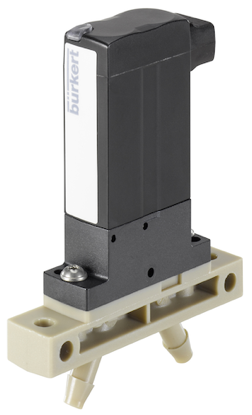As a leading solenoid valve manufacturer, Bürkert knows more than most about how a solenoid valve works. For this reason, they have set out to answer some of the most frequently asked questions about the function of a solenoid valve, potential solenoid valve applications and why you should choose Bürkert as your solenoid valve supplier in their latest article for PIF.

What is a solenoid valve?
The definition of a solenoid valve is:
“An electro-mechanical valve that is commonly employed to control the flow of liquid or gas”.
ON/OFF Solenoid valves use two functional principles. Direct acting is where the power generated in the coil/spring is sufficient to open the valve on its own. Or Servo-assisted solenoid valves, whereby a main valve is controlled by a solenoid-operated pilot valve with smaller flow cross-sections and lower electrical control power. The main valve uses a diaphragm or a piston as a moving closure element for opening and closing the fluid path.
These valves rely on the process fluid pressure to assist in the opening or closing of the main valve and therefore need a pressure differential to work. Direct acting valves can work from zero pressure, whilst servo-assisted valves need a minimum pressure of between 0.5 or 1 bar – depending on the design.
How does a direct acting solenoid valve work?
All solenoid valves are designed using tightly coiled copper wire to create a magnetic field. The force created by this field pushes or pulls a piston up or down. The loser seat controls main line flow, and when the seat is closed no fluid passes from P to A. The upper seat controls the exhaust port.
Direct acting valves are designed for fast switching, with direct application of power. In this way, the valve uses applied power directly and is therefore called a direct acting valve. When power is applied (i.e. the valve is ‘energised’) the plunger is pulled up, the lower seat is opened and the fluid flows from P to A. When power is removed (or the valve is ‘de-energised’), the fluid remaining inside the valve exits through the R exhaust port.
Direct acting solenoid valves are the work-horse of process control. They occur in most main or ancillary processes in manufacturing, with valve switching time measured in fractions-of-a-second. In short, they are humble but important pieces of equipment. Find out more in this short vodcast from Bürkert.
Where is a solenoid valve used?
Solenoid valve applications include a broad range of industrial settings, including general on-off control, plant control loops, process control systems and various original equipment manufacturer applications, to name but a few.
Perhaps unsurprisingly then, Bürkert solenoid valves can be found in many different sectors:
• Water supply
• Treatment of drinking water
• Waste water treatment
• Purification/ treatment of grey and black water
• Machine and plant engineering
• Cooling, lubrication and dosing
• Water mains protection and fire extinguishing systems
• Compressors
• Pressure relief and drainage
• Fuel supply
• Transport and tank facilities
Why choose Bürkert solenoid valves?
Bürkert is famed for quality and excellence in the sector of fluid technology. Their products are used wherever fluids and gases need to be measured, controlled and regulated. Bürkert has been developing and producing solenoid valves for more than 60 years. In doing so, they use recognised technical principles and unique technologies with a common goal: to fulfil your requirements. View their solenoid valves brochure for more information.
Bürkert customise their valves to fit your applications and therefore offer you the optimal solution for your needs. That is why their valves can be found in virtually every industry. From welding robots to waterworks, to cabin pressure control in aircraft – everything is possible with their valves as a reliable component in your system. Whether you need a single valve, valve blocks or customised solutions, Bürkert’s entire product line is oriented toward ensuring controlled handling of liquids and gases.
Their products are designed to deliver:
• High flexibility due to modular design
• Diverse choice of materials
• High reliability and long service life
• Low environmental impact
When it comes to working with liquids and gases, Bürkert are at your side; as a manufacturer of sophisticated products, as a problem-solver with an eye for the big picture and as a partner offering you reliable advice. Contact Bürkert for more information.

